Brad Pitt and Damson Idris: Transforming Into F1 Drivers for the Big Screen
An upcoming F1 movie starring Brad Pitt and produced with Lewis Hamilton could feature the most viscerally realistic racing scenes ever. Chris Medland explains the lengths the production crew is going to
Getty Images
Silverstone Circuit could have a new name this summer. No, not a branding exercise or title sponsorship deal, but it has diversified as the perfect location for Hollywood to base itself in the United Kingdom. That’s right: Silverstone Studios is here.
For eight weeks prior to the British Grand Prix, the venue had become the base for the as-yet-untitled Formula 1 film that is being directed by Joseph Kosinski and produced by Jerry Bruckheimer and Chad Oman. There are so many others involved, but that trio – along with writer Ehren Kruger – all worked on Top Gun: Maverick together. That should tell you all you need to know about the level of production that is being attempted.
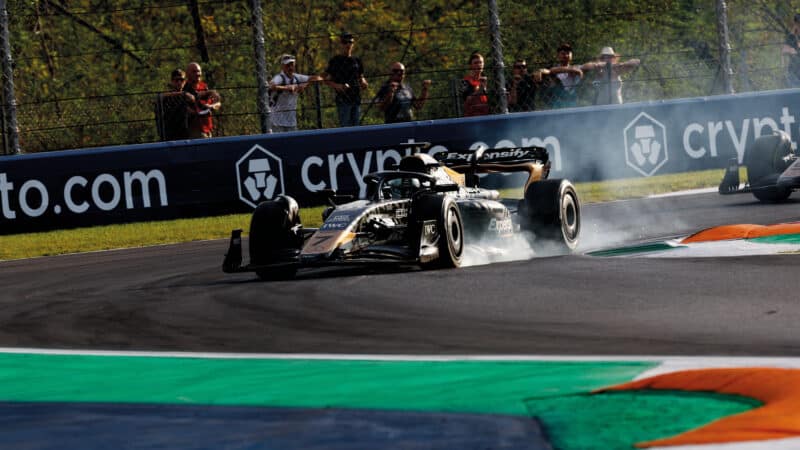
The APXGP cars have already run at multiple F1 races, including the Italian GP at Monza
Let’s not kid ourselves, producing an authentic racing movie is close to impossible. Unless it’s a documentary, the availability of locations, personnel and equipment are huge barriers that need to be overcome in the smartest of ways.
Take the new Gran Turismo film, for example. Based on the true story of Jann Mardenborough’s journey from gamer to professional driver – including an LMP2 podium on debut at Le Mans – it needed little writing given the tragedy he also faced at the Nürburgring in 2015 (his car cartwheeled off the track and killed a spectator). It’s a story that had the highest of highs and the lowest of lows. And yet, just as the game itself was a way to make motor sport more accessible, the film attempts to do similar by increasing the drama in what feels like an over-the-top way, including photo-finishes at every opportunity, changing down a gear on a straight to overtake with ease, or accelerating into a corner to do the same.
There’s obviously a bad guy, who appears intent on driving everyone off the road. Oh, and Silverstone is actually the Hungaroring in reverse. And the Circuit de la Sarthe is also the Hungaroring, but at least in the correct direction this time. And that’s fine when a film commits to being solely entertaining at the cost of authenticity – there’s still a great story being told. But that isn’t the case with the F1 attempt.
Brad Pitt playing a returning veteran at 59 is pushing the realms of reality, but his character Sonny Hayes looked every bit the fit older athlete he’d need to be on debut at Silverstone.
Well, I say on debut, but that does a massive disservice to Pitt and his co-star Damson Idris – who is playing team-mate Joshua Pearce. To prepare, they’d been driving for nearly six weeks, at Silverstone and elsewhere, with the support of Trevor Carlin and his eponymous team. Professional driver coaches were brought in on top of those who would also film scenes, to make Pitt and Idris as accomplished as possible.
That meant experience of karts, lower formula cars and then F2 machinery, all to get them accustomed to the amazing concoctions they would have to pilot and still have the capacity to act or follow specific direction.
The film cars themselves are F2 chassis that have had a spacer added to give the correct dimensions and wheelbase. Then the bodywork has been developed in conjunction with Mercedes to make them look as much like an F1 car as possible, but also take the camerawork to the next level.
The cinematography of Top Gun: Maverick is one of its most incredible features. Special camera development with Sony allowed devices to be mounted within fighter jets that could capture high-g turns and ensure filming was taking place in the air, in real planes, with natural light and backgrounds, rather than using a green screen.
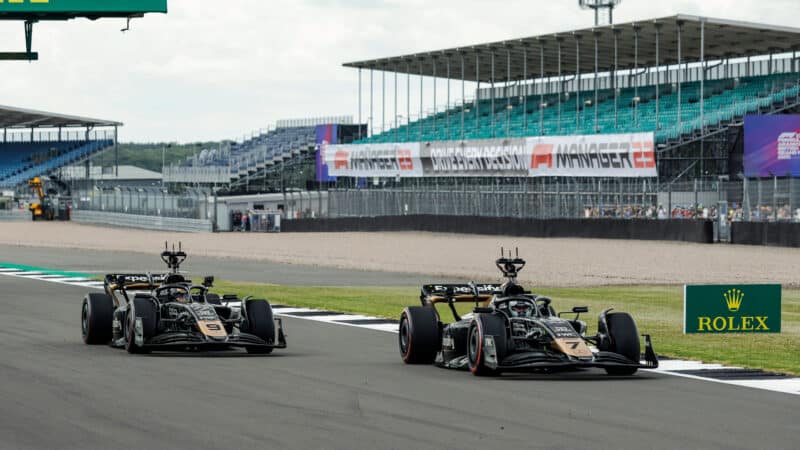
Clever camera tech has been integrated within the cars, which are modified F2 chassis.
The Filmmakers Academy said that Top Gun: Maverick’s solutions “revolutionised aerial cinematography”. Kosinski says that technology now pales into insignificance compared to the advancements made to capture the F1 footage.
Cameras that have had a further number of years in development have been integrated into the chassis and bodywork to both keep weight increases to a minimum and provide spectacular angles without the need for ugly appendages to be removed in post-production.
That footage is added to courtesy of Formula One Management also being involved to offer cinema-quality feeds from live track action, including special cameras in existing housing points on the regular 20 cars.
That all allows the film’s cars to run on track during tiny windows in race weekends to capture scenes. Six cars in total had been prepared and two were running together at Silverstone from Thursday onwards, resulting in footage from an actual race weekend.
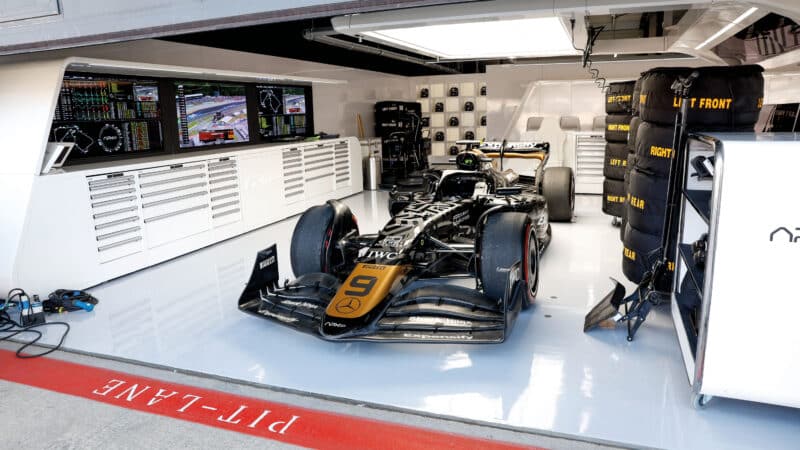
The garage is authentic enough.
That first day was understandably full of interest in the fictional APXGP team that had appeared in the paddock, with its own motorhome and full garage set-up that existing constructors might even be running an eye over. When not rehearsing, cast members were transfixed by pitstop practice from neighbouring Ferrari, all while other F1 personnel stood staring back at the new arrival.
But it’s testament to the level of detail and investment that within a day the novelty had worn off. Aside from filming a scene of Idris arriving in the paddock in civvies just like any driver – using a TechnoCrane camera that did stand out – the entire outfit just blended in.
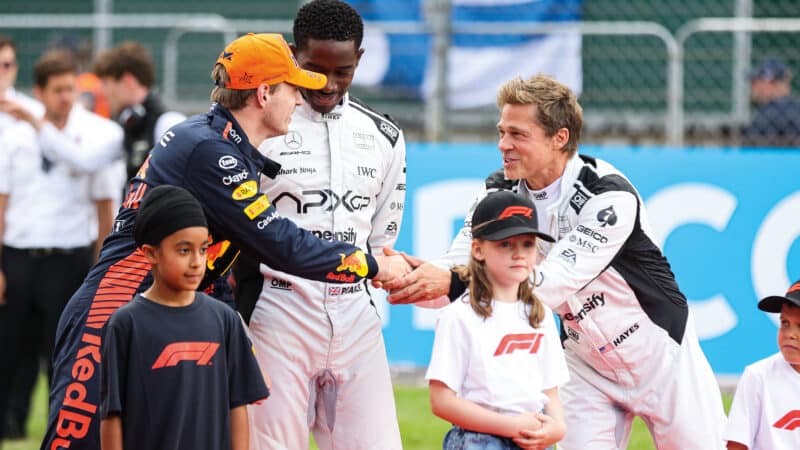
Meeting your heroes, but which way around is it for Pitt and Verstappen?
While I’m sworn to secrecy on the content of some of the scenes that were being filmed during the weekend, APXGP’s presence soon became normal when they weren’t clearly shooting. So many of the crew wore team kit that it didn’t stand out among the other 10 teams, in fact regularly being mistaken for existing team members given the colour scheme and sponsors.
“Perhaps having learned from the reluctance to fully commit to Drive to Survive, some F1 drivers showed a willingness to get involved rather than avoid cameras”
Although there were up to 400 people on site – spread across a unit base at Stowe, car operations in the National pits, and the set and facilities behind the team’s main garage – in terms of paddock numbers the passes rotated so that there was only ever a similar number of personnel in that area than any actual F1 team would receive.
It was all intentional, and all had been meticulously planned. Recces had taken place in Bahrain, Baku, Miami, Spain and Austria during the first part of the season, bringing different people involved with the film each time to ensure they knew exactly what they were dealing with once jumping into the action at Silverstone.
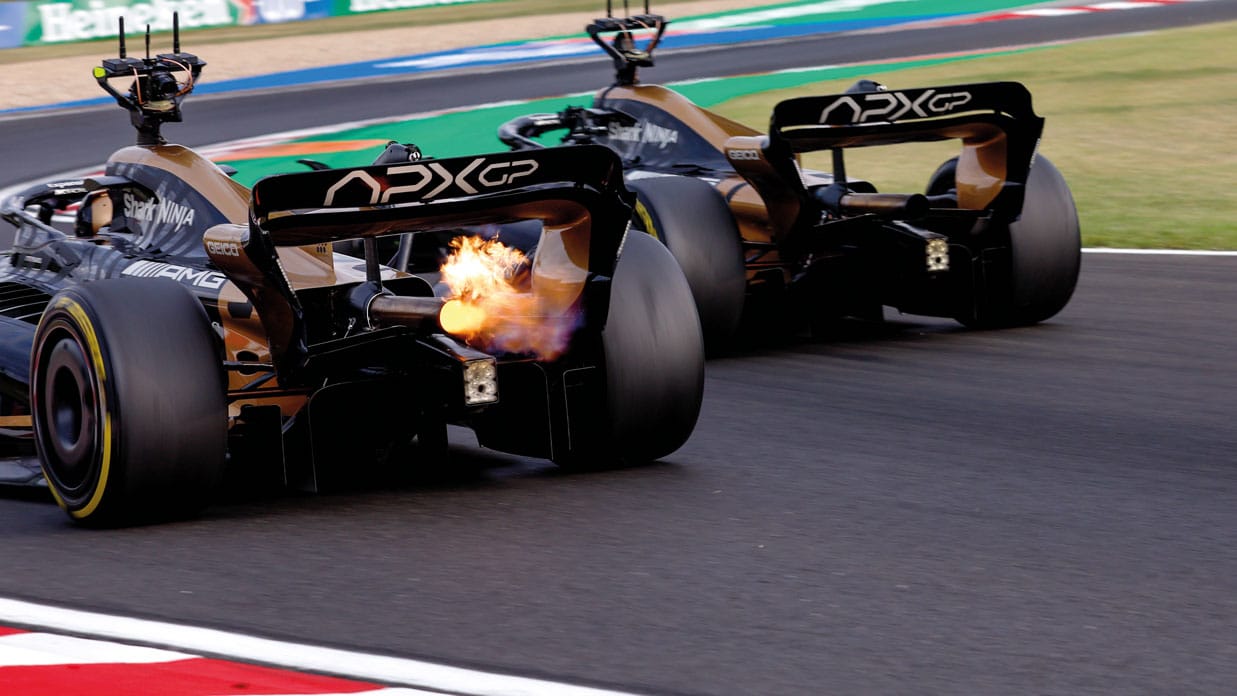
That had the knock-on impact of ensuring minimal disruption when filming as the fictional team didn’t draw attention.
Standing in the pitlane pre-race, suddenly Pitt and Idris walked onto the grid ready to complete a scene, and in full overalls with the same number of people around them as any other driver, they simply blended in.
Even adding the cars to the back of the grid – Pitt has already revealed that the team is a struggling one that he’s returned to help – meant space for camera crews to operate without interfering with the rest of the field.
How often have you watched an interview with a driver striding towards their car on the grid? This will feature multiple cameras and sound engineers walking backwards in front of them to capture the discussion, and much of the work being done by the film crew was along similar lines to this.
Perhaps having learned from the reluctance to fully commit to Drive to Survive when it first started filming, some F1 drivers showed a willingness to help elevate scenes by getting involved rather than avoiding the cameras. Carlos Sainz positioned himself by Pitt for his stroll back to his car pre-race, while in Budapest two weeks later Lewis Hamilton climbed out of his car and spontaneously congratulated Idris’s character, who was celebrating while filming a scene in a live parc fermé.
The early momentum was slowed by the strikes that hit Hollywood in July, meaning actors who are part of the Screen Actors Guild – American Federation of Television and Radio Artists (SAG-AFTRA) trade union downed tools. Pitt wasn’t in Hungary as a result, but filming could continue at the Hungaroring with professional drivers and certain crew members.
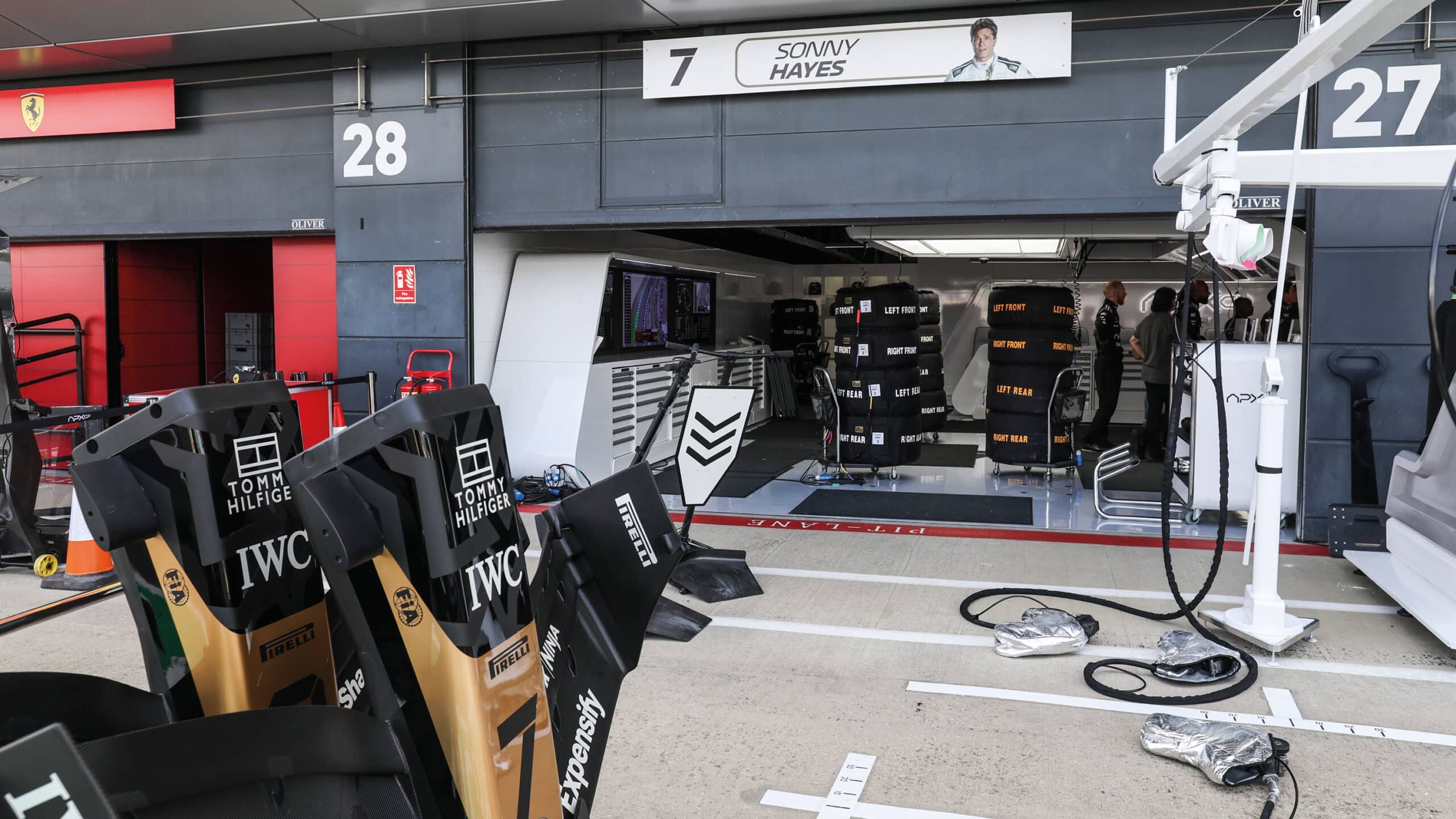
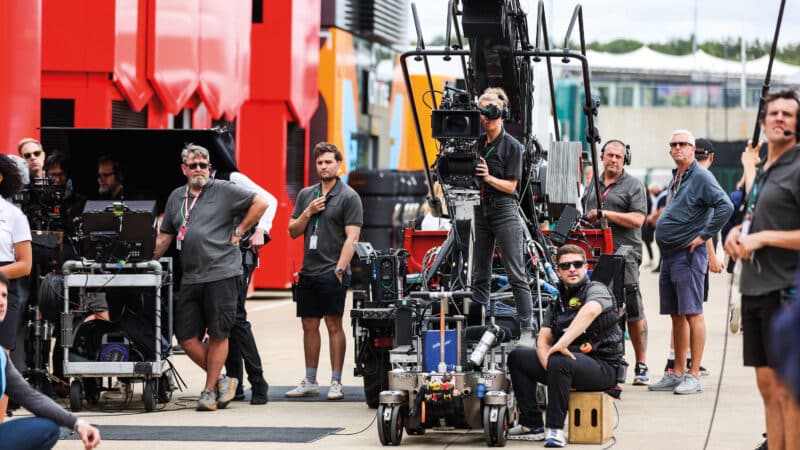
Crew at work shooting in the pitlane, but not obtrusively
And F1 personnel…
A true F1 film requires all of the main characters to be involved, and Guenther Steiner’s acting skills were required on the pitwall in Budapest. Direction came from the team’s head of communications to again ensure it was handled like any other media request, with a Haas team member stood amid all of the film crew next to Kosinski and providing instructions to Steiner via team radio.
It was one of many examples of the meshing of the motion picture industry with the F1 paddock. A movie of this scale would tend to have far more than those involved on-site at races, but as it doesn’t get to film on its own terms then it has to adapt to the world of grand prix racing. There will need to be a similar adaptation from hardcore fans to the storyline itself – it’s still a Hollywood movie after all – but the world in which it takes place is going to be portrayed as authentically as anything we’ve ever seen before.